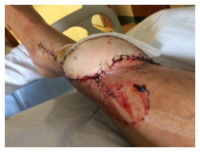A Baseball Bruise Leads to a Battle for Limb Salvage - Part 2
Part two of a four-part series about an athlete’s journey to save his leg.
(In part one, JH, age 62, was hit in the shin by a baseball. A hematoma developed that became infected; treatment included opening and draining the hematoma and discharge to home to self-administer IV antibiotics through a PICC line.)
Sitting on the sofa in his den the day after discharge, JH had his leg propped up. Looking at the wide-open wound, he knew something wasn’t right. With waning confidence in the situation, JH thought the injury looked worse after the treatment to drain it than it did before the hospital visit.
Though JH and his wife had videotaped the home care nurse’s instructions to administer the IV medication, the effort did not go well. Unable to make the tubes connect, blood began pouring from the PICC line, saturating his clothing. In the midst of this, his physician friend responded to the photos. He told JH to go immediately to the hospital, not to stop for breakfast, not to change clothes – but to go immediately.
Having gotten the PICC line capped, JH took an Uber to a Philadelphia medical center. After a long wait in the ED, JH was admitted, evaluated, and quickly scheduled for surgery to debride the wound. In surgery, tissue from the shin was debrided to the bone. The wound was covered but did not begin healing the way his care team had hoped.
Three days after the first surgery, a second surgery was required for additional debridement. This time a vacuum drain was inserted into the area and sealed with a clear wrap with suction applied to the wound. Lab cultures returned positive for Staphylococci. JH began to comprehend more fully the conversations with the physicians about the infection spreading more seriously into the bones in his leg and the growing concern that amputation might be required to prevent systemic infection or even death.
 JH is part of a well-connected long-time Main Line Philadelphia family. Those connections enabled him to be placed in the care of a renowned physician known most recently for successful pediatric hand transplants. JH was evaluated and a course of action was determined. In a third surgical procedure, a full-thickness flap, with vasculature, was harvested along with a graft of skin shaved from his thigh, all transplanted to the lower leg. The purpose was to create a “biologic dressing”—the patient’s skin, that would protect against bacterial contamination and hasten to heal.
JH is part of a well-connected long-time Main Line Philadelphia family. Those connections enabled him to be placed in the care of a renowned physician known most recently for successful pediatric hand transplants. JH was evaluated and a course of action was determined. In a third surgical procedure, a full-thickness flap, with vasculature, was harvested along with a graft of skin shaved from his thigh, all transplanted to the lower leg. The purpose was to create a “biologic dressing”—the patient’s skin, that would protect against bacterial contamination and hasten to heal.
After seven hours of surgery, JH awoke in the ICU. In the event of flap failure, JH needed to remain under close watch. The care team monitored the pulse in the surgical area.
 The flap was an ecosystem – a living environment around the initial bruise site that supported tissue repair and healing and covered that bone. JH called it a “hoagie roll” – a protrusion on his lower leg that extended about six inches along a left to right down angle across his leg. The plan seemed to be working. The swelling decreased, the infection seemed to be clearing. For the first time, the wound was sutured closed and wrapped. Discharge care included topical antibiotic ointment for the sutures and instructions to keep the wound covered. The pain was gone.
The flap was an ecosystem – a living environment around the initial bruise site that supported tissue repair and healing and covered that bone. JH called it a “hoagie roll” – a protrusion on his lower leg that extended about six inches along a left to right down angle across his leg. The plan seemed to be working. The swelling decreased, the infection seemed to be clearing. For the first time, the wound was sutured closed and wrapped. Discharge care included topical antibiotic ointment for the sutures and instructions to keep the wound covered. The pain was gone.
For the next 10 days, JH healed. Back at work with the wound covered by the “hoagie roll,” he was on a trajectory toward full recovery. With sutures out and butterfly bandages along the repair line, JH was confident he would soon return to the baseball diamond. Instead, he was to return to surgery for a fourth, fifth and sixth time. He and his leg remained in danger.
(In part three, JH faces emergency surgery, a maggot infiltration and the specter of a polymicrobial infection. His game is far from over and a win, even with the best players and tools, is not a sure thing.)
About the Author
Dr. Pollack is certified in Emergency Medicine and is a founding board member of the Hospital Quality Foundation. Visit: www.hospitalqualityfoundation.org.


